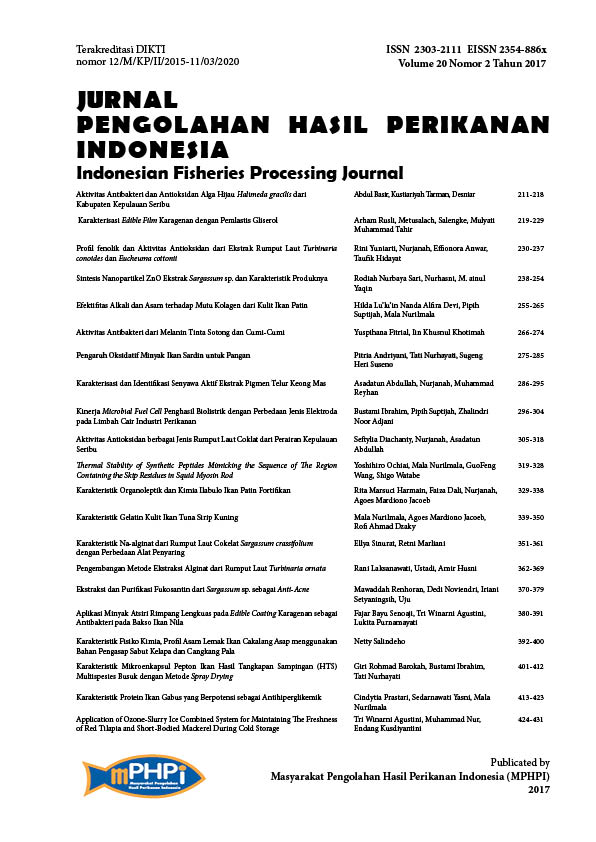Organoleptic Characteristics and Chemicals Ilabulo Catfish Fortification
Abstract
Diversification of traditional food ilabulo made from raw catfish (Pangasius sp.) has the potential to be developed in Gorontalo province to substitute chicken viscera. The research aimed to make ilabulo substitute the raw material of chicken viscera with the catfish fortified Kappaphycus alvarezii seaweed and catfish bone meal and to determine the organoleptic and chemical characteristics of ilabulo catfish fortification. Fortified treatment is K. alvarezii and catfish bone (5 dan 10% ), B (10 and 15%) and C (15 dan 20%). The organoleptic analysis used a hedonic scale of favorite criteria on the appearance, texture, color, flavor, and taste. The results of organoleptic analysis continued with Bayes test. The chemical analysis used the Association of Official Analytical Chemist method. The result of the hedonic characteristic of ilabulo catfish fortification was on the appearance neutral criteria – like (5.53–7.03), texture neutral criteria – rather like (5.8–7.1), aroma rather like (6.3–6.73), color neutral – like (6.1–7.03) and taste (6.07–6.53) neutral criteria – rather like. The result of Bayes test obtained by a texture of importance value 5, appearance importance value 5, aroma of importance value 4, color of interest value 3 and taste of importance value 2. Characteristic of ilabulo culture of selected fortified catfish that was the fortification of K. alvarezii seaweed 15% and catfish bone flour (20%) (fortification C) obtained by water content 56.46%, ash 11.54%, protein 7.78%, fat 8.91%, coarse fiber 0.61%, carbohydrate 22.07% and calcium 0.315 %.
Authors
HarmainR. M., DaliF., NurjanahN., & JacoebA. M. (2017). Organoleptic Characteristics and Chemicals Ilabulo Catfish Fortification. Jurnal Pengolahan Hasil Perikanan Indonesia, 20(2), 329-338. https://doi.org/10.17844/jphpi.v20i2.18015
Authors who publish with this journal agree to the following terms:
- Authors retain copyright and grant the journal right of first publication with the work simultaneously licensed under a Creative Commons Attribution License that allows others to share the work with an acknowledgement of the work's authorship and initial publication in this journal.
- Authors are able to enter into separate, additional contractual arrangements for the non-exclusive distribution of the journal's published version of the work (e.g., post it to an institutional repository or publish it in a book), with an acknowledgement of its initial publication in this journal.





